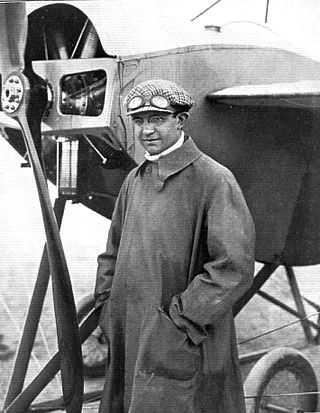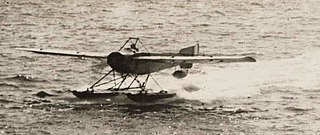
Aermacchi was an Italian aircraft manufacturer. Formerly known as Aeronautica Macchi, the company was founded in 1912 by Giulio Macchi at Varese in north-western Lombardy as Nieuport-Macchi, to build Nieuport monoplanes under licence for the Italian military. With a factory located on the shores of Lake Varese, the firm originally manufactured a series of Nieuport designs, as well as seaplanes.

The Coupe d'Aviation Maritime Jacques Schneider, also known as the Schneider Trophy, Schneider Prize or (incorrectly) the Schneider Cup is a trophy that was awarded first annually, and later biennially, to the winner of a race for seaplanes and flying boats. In 1931 Britain met the conditions to retain the Trophy permanently; it is held at the Science Museum in South Kensington, London.

The Robert J. Collier Trophy is an annual aviation award administered by the U.S. National Aeronautic Association (NAA), presented to those who have made "the greatest achievement in aeronautics or astronautics in America, with respect to improving the performance, efficiency, and safety of air or space vehicles, the value of which has been thoroughly demonstrated by actual use during the preceding year."
The Air Battalion Royal Engineers (ABRE) was the first flying unit of the British Armed Forces to make use of heavier-than-air craft. Founded in 1911, the battalion in 1912 became part of the Royal Flying Corps, which in turn evolved into the Royal Air Force.

Charles Terres Weymann was a Haitian-born early aeroplane racing pilot and businessman. During World War I he flew for Nieuport as a test pilot and was awarded the rank of Chevalier of the Legion of Honour.

The Nieuport 10 is a French First World War sesquiplane that filled a wide variety of roles, including reconnaissance, fighter and trainer.

Blériot Aéronautique was a French aircraft manufacturer founded by Louis Blériot. It also made a few motorcycles between 1921 and 1922 and cyclecars during the 1920s.

The Nieuport VI was a sport monoplane produced in France in the 1910s, a further development by Nieuport along the same general lines as the Nieuport II and Nieuport IV, differing mainly from the Nieuport IV in being slightly larger. Like the Nieuport IV, it was used by various military air arms as a reconnaissance aircraft and trainer.
The Benoist Aircraft Company was an early manufacturer of aircraft in the United States. It was formed in 1912 in St Louis, Missouri, by Thomas W. Benoist. Over the next five years, it would build 106 aircraft, including Benoist XIVs that would be used for the first heavier-than-air airline service. The company dissolved with Tom Benoist's accidental death in 1917.

The Loughead Aircraft Manufacturing Company was an American company which designed and built aircraft. The founder, Allan Lockheed, went on to form the similarly named but otherwise unrelated Lockheed Aircraft Company in 1926, which would merge with Martin Marietta in 1995 to form today's Lockheed Martin.

The Nieuport IV was a French-built sporting, training and reconnaissance monoplane of the early 1910s.

Cecil Howard Pixton was a British aeronautical engineer, test pilot and air racing pilot who was most famous for winning the 1914 Schneider Trophy seaplane race.

The Dunne D.8 of 1912 was a tailless swept wing biplane, designed by J. W. Dunne to have inherent stability. One example was supplied to RAE Farnborough. License-built Burgess-Dunne models were used by the US Signal Corps and United States Navy and the short-lived Canadian Aviation Corps. It was the latter's first and only warplane.

Weldon Bagster Cooke was a pioneer aviator.

The Wright Model E was the first in the series of Wright Flyers that used a single propeller The aircraft was also the test demonstrator for the first automatic pilot control.

The United States capital, Washington, D.C., has been the site of several events in the nation's history of aviation, beginning from the time of the American Civil War, often for the purpose of promoting the adoption of new aeronautical technologies by the government. It has also been home to several aircraft manufacturers and aviation organizations, and many aerospace contractors have maintained a presence there as well.

Thomas W. Benoist was an American aviator and aircraft manufacturer. In an aviation career of only ten years, he formed the world's first aircraft parts distribution company, established one of the leading early American aircraft manufacturing companies and a successful flying school, and from January to April 1914 operated the world's first scheduled airline.

The Gordon Bennett Aviation Trophy is an international airplane racing trophy that was awarded by James Gordon Bennett Jr., the American owner and publisher of the New York Herald newspaper. The trophy is one of three Gordon Bennett awards: Bennett was also the sponsor of an automobile race and a ballooning competition.
Gyro Motor Company was an American aircraft engine manufacturer.

The Hanriot D.I was a French monoplane racing aircraft, designed in France in 1912 and strongly influenced by Nieuport practice. Examples were built and raced both in France and the UK during 1912.
















